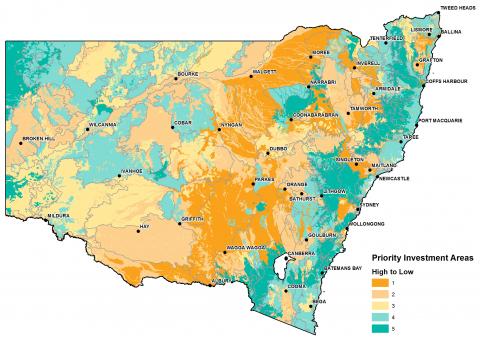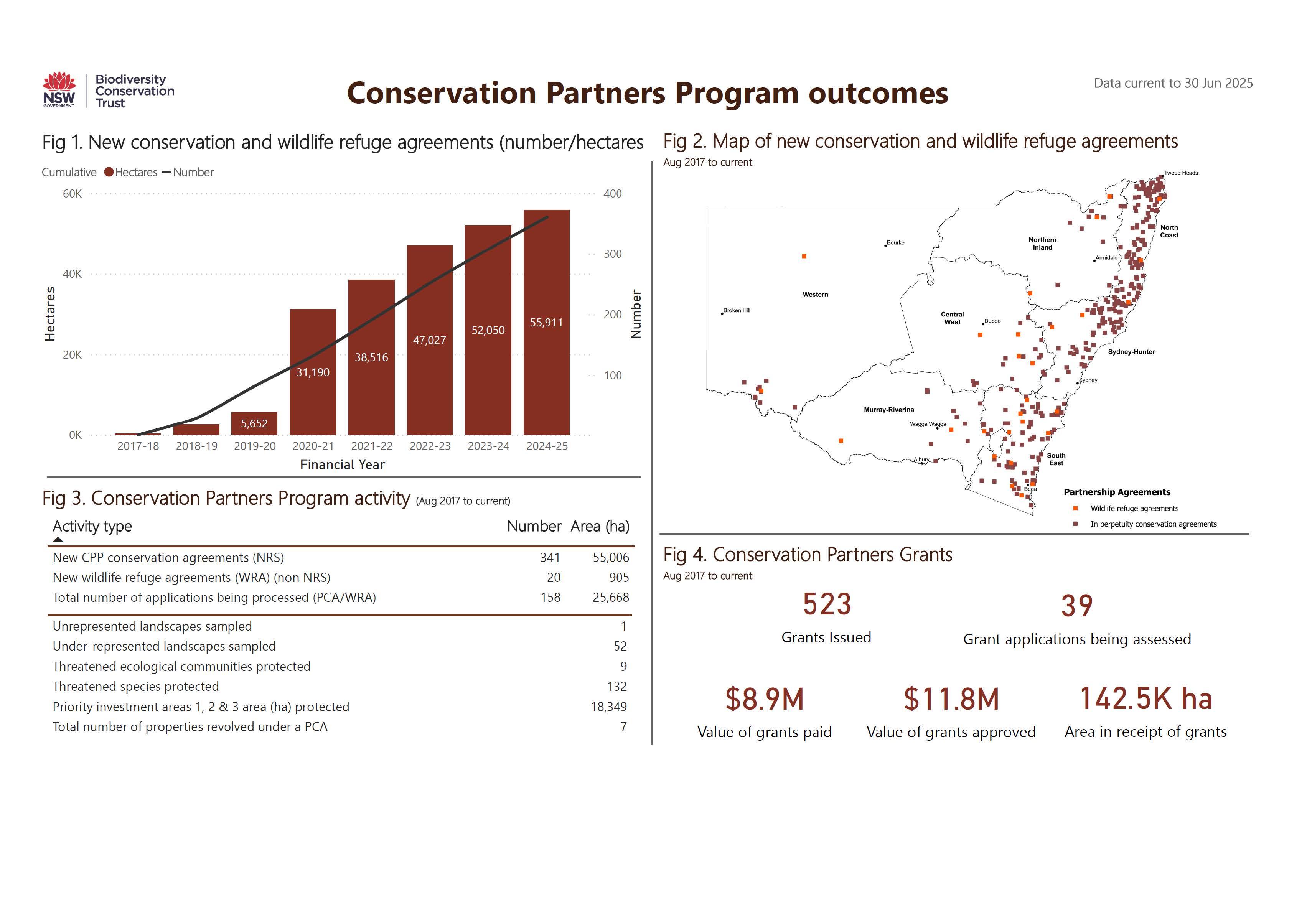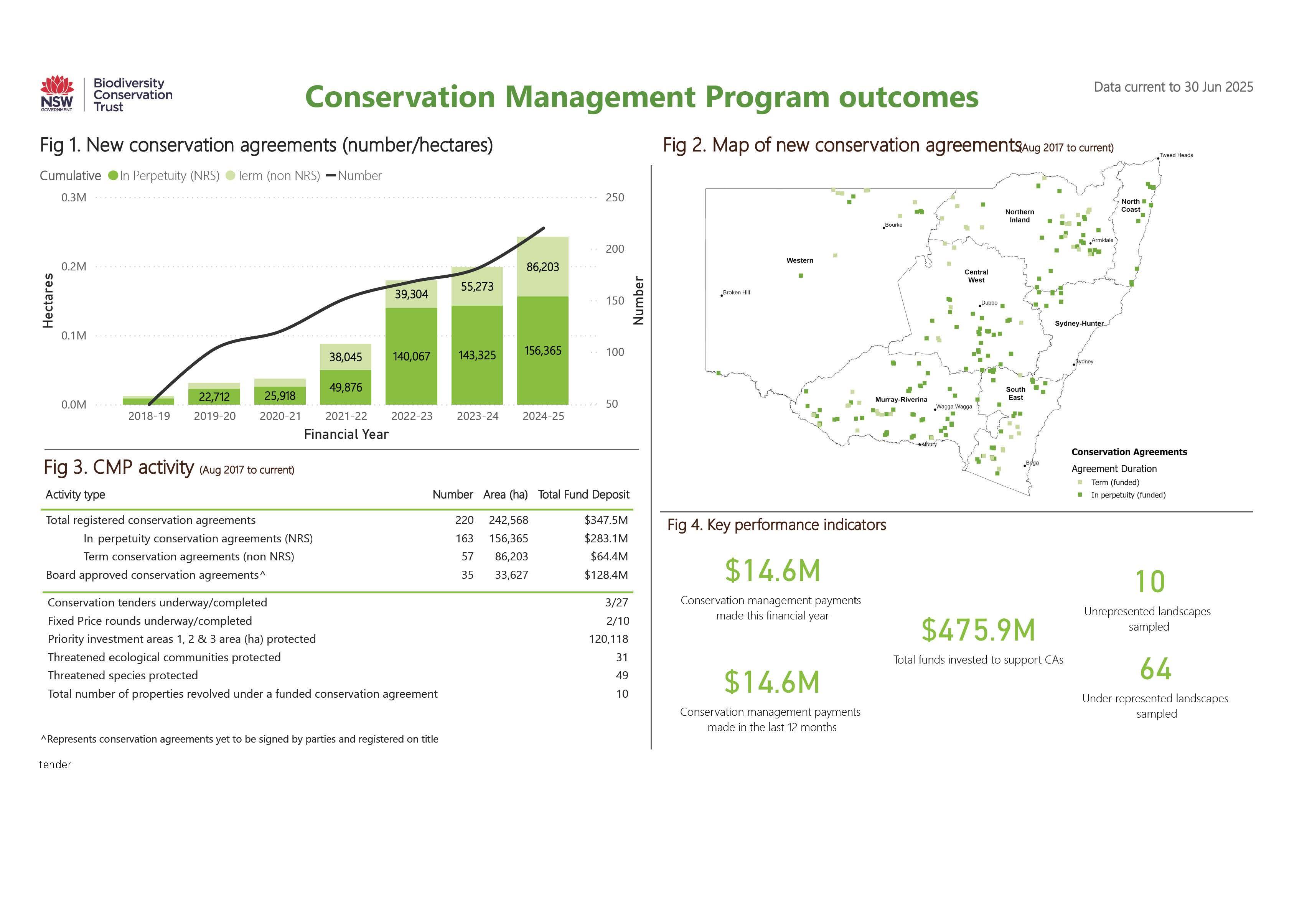Private Land Conservation Outcomes
Private Land Conservation Outcomes
The NSW Biodiversity Conservation Trust is managing 2,564 Private Land Conservation agreements with landholders across more than 2.1 million hectares.
Since 2017, 616 landholders have entered or plan to enter a conservation agreement with the NSW Biodiversity Conservation Trust, creating conservation areas across 332,106 hectares.
The NSW Biodiversity Conservation Trust is investing more than $475.9 million to support these agreements. This investment is split 73 per cent for in-perpetuity agreements and 27 per cent for term agreements (minimum 15-years). The median annual payment to agreement holders is $103 per hectare with a typical annual payment at around $52,000.
As a result, many unique landscapes, many threatened ecosystems, and habitats for our threatened native plant and animal species are now protected and being managed by private landholders for conservation.
Agreements with the NSW Biodiversity Conservation Trust protect at least 305 unique threatened species and at least 41 threatened ecological communities.
Landholders with partnership conservation agreements are eligible to apply for Conservation Partners Grants.
The NSW Biodiversity Conservation Trust has approved Conservation Partners Grants worth $11.8 million to 523 landholders across 142,500 hectares.
Priority Investment Areas
Protecting NSW Landscapes
Target 1 in the BCIS states: By 2023, private land conservation agreements will protect examples of 30 NSW Landscapes that are either not represented within, or are inadequately protected in, the protected area system in 2017.
The NSW Biodiversity Conservation Trust met Target 1 in February 2019, four years early. So far, new conservation agreements are protecting examples of 18 landscapes not previously represented within the protected area system and 162 landscapes that are inadequately protected.
Under the Biodiversity Offsets Program the NSW Biodiversity Conservation Trust has protected 7 NSW landscapes not previously represented within the protected area system and 46 NSW landscapes that are inadequately protected.
Reaching Target 1 means that the BCT has contributed progress towards meeting CAR targets. However, this does not mean these NSW Landscapes are now adequately protected or that CAR targets have been met. The BCT will now focus on achieving Target 3, to sample a further 90 unique, unrepresented or, inadequately-protected NSW Landscapes.
Diversifying Incomes
Target 3 in the BCIS states: By 2023, diversified incomes streams will improve the financial sustainability of participating landholders relative to similar local businesses.
Under funded conservation agreements, 220 landholders have received annual payments worth $14.6 million over the past 12 months to manage 242,568 hectares of conservation areas providing these landholders with an additional source of income.
Many of the highest priority investment areas identified in the BCIS are in the NSW sheep-wheat belt, which stretches the length of the state from the Queensland border to the Victorian border. These areas are our agricultural heartland and support most of the cereal-growing areas and much of the irrigated farmlands of New South Wales. These areas have been extensively cleared for grazing and cropping and there is a relatively low proportion of land in the protected area system. Therefore, the BCT is directing most of its investment in funded conservation agreements in this high-priority part of NSW.
As a result, around two-thirds (66 per cent) of the BCT’s investment in funded conservation agreements is flowing to graziers, farmers or mixed farming enterprises. These farmers are being paid by the BCT to manage parts of their properties for conservation. The BCT has also invested in threatened grasslands in the Monaro and in high-priority koala habitat on the North Coast.
A December 2020 survey showed 69 per cent of 141 participating landholders with a funded conservation agreement agreed that signing an agreement with the NSW Biodiversity Conservation Trust had diversified their income (with 15 per cent unsure/neutral and 15 per cent disagreeing).
Conservation Partners Program - Outcomes To Date
The Conservation Partners Program is for landholders wishing to protect and manage biodiversity on their land. It is available for landholders who are ineligible to participate in the Conservation Management Program or not seeking a funded agreement.
Outcomes
Landholders wishing to permanently protect and conserve biodiversity on their land can apply to enter an in-perpetuity conservation agreement with the BCT at any time. A wildlife refuge agreement is an option for landholders who wish to protect their land but do not want to enter a permanent agreement. The BCT has received over 150 applications and we have ramped up our capacity to respond to this demand.
These agreements include many threatened species of fauna such as the grey-headed flying-fox, the glossy black-cockatoo, the brush-tailed phascogale, the Southern pink underwing moth and the koala, and threatened species of flora including the native milkwort, square-fruited ironbark, sandstone rough-barked apple, Wee Jasper grevillea, and the Southern ochrosia.
Revolving Fund
To date, the BCT has revolved 8 properties and is currently in the process of selling another 1 property under the Conservation Partners Program.
Conservation Partners Grants
All landholders with an agreement that does not include annual conservation payments can apply at any time for a conservation partners grant. Grants can assist landholders to maintain the ecological values of their properties. Find out more.
The NSW Biodiversity Conservation Trust is assessing grant applications on an ongoing basis. To date, the Trust has approved grants worth $11.8 million to 523 landholders covering more than 142,500 hectares.
Conservation Management Program - Outcomes To Date
The BCT’s Conservation Management Program is for landholders in priority investment areas or with conservation assets seeking to enter agreements with annual conservation management payments. The BCT uses a range of mechanisms—conservation tenders, fixed price offers and revolving fund —to encourage landholders to participate.
Conservation Management Program Outcomes
These conservation areas contain endangered ecological communities such as Semi-evergreen Vine Thicket, Inland Grey Box Woodland, and White Box-Yellow Box-Blakely's Red Gum Grassy Woodland and Derived Native Grassland.
Revolving Fund
To date, the BCT has revolved 10 properties and entered funded conservation agreements with the new landholders. The BCT is currently in the process of selling 3 properties under the Conservation Management Program.
Conservation Tenders
NSW Biodiversity Conservation Trust conservation tenders have so far resulted in 220 conservation agreements covering more than 242,500 hectares of high-conservation value land and ecological assets across the state.
Fixed price offers
NSW Biodiversity Conservation Trust fixed price offers have so far resulted in 38 conservation agreements covering more than 48,390 hectares of high-conservation value land and ecological assets across the state.




